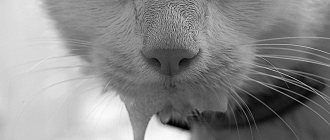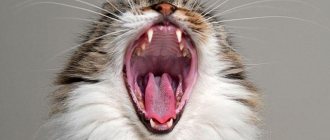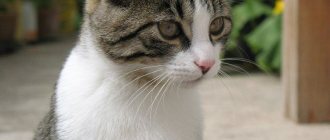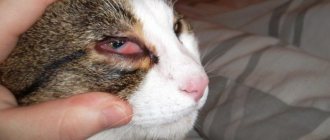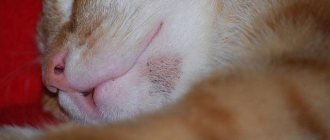Whiskers are one of the most recognizable features of a cat. However, they serve more than just aesthetics. Cats rely on their whiskers to negotiate with the world and stay safe.
The whiskers should be equal to the length of the cat's body. This allows you to evaluate whether it can fit in a narrow space. Whiskers also help cats when hunting and moving around. Cats cannot see in complete darkness and are nominally farsighted. Thus, very long whiskers allow the cat to feel its way in places that it cannot see well. Unfortunately, problems can arise with the “whisker test” when the cat has become overweight.
Even if the cat's whiskers seem too long, under no circumstances should they be trimmed. Just trust nature to determine the length of your cat's whiskers. If your cat's whiskers grow too long, they will naturally fall off and grow back over time.
Whiskers on cats
Author: Kotizm · March 6, 2016
Many people wonder whether cats have black whiskers and why they fall off and break off. It will be equally interesting to find out what they are correctly called and what function they perform in cats, cats and kittens, because few of those who keep such cute pets in an apartment or private house know about this.
The article discusses basic questions about cat whiskers, interesting facts and everything that every cat lover should know about their pet, so that in case of any problem, they can correctly provide help and know what needs to be done.
What are cats' whiskers called?
Whiskers in cats are scientifically called vibrissae. It is believed that a cat's whiskers are thickened and coarse hairs endowed by nature with mechanical sensitivity.
Is it possible to cut or trim a cat's whiskers?
Trimming a cat's whiskers is strictly contraindicated. A cat without a mustache will not be able to navigate in space. Whiskers serve as tactile and olfactory receptors.
Why does a cat need mustaches and eyebrows, what are they needed for, what are they responsible for
Whiskers and eyebrows in cats (more correctly whiskers) are needed so that the animal can navigate in space. These are natural navigator antennas.
Why do cats and kittens' whiskers break, fall out, and become long?
Periodic loss of whiskers in cats, with replacement with new ones, is the norm. If the whiskers fall out or break off intensively, this is a sign of a malfunction in the animal’s body.
Mustache loss can be caused by: - lack of vitamins; - due to food allergies; — malfunctions of the thyroid gland; - skin diseases of a fungal nature or caused by parasites (notoedrosis or microsporia).
It is paradoxical, but true, that long and thick whiskers in cats are not always a sign of excellent health. Scientists have found that their carriers often have impaired vision.
Why do cats have white whiskers and turn white?
A sharp change in the color of the mustache to white may indicate the onset of a disease, for example, giardiasis. It is clear that without a clinical examination it is impossible to establish an accurate diagnosis, and therefore the cause of the whitening of the cat’s whiskers. Sometimes the whiskers of a healthy animal turn white, but it’s better to be safe and resolve your doubts.
Why do cats' whiskers turn black?
Black whiskers in cats are not associated with any disease, so there is no reason to worry. The color change is caused by modifier genes.
Do cats' whiskers grow and grow?
Cats' whiskers are periodically renewed - they fall out and grow back. But specifically cutting (to make it thicker) or straightening (to make it more beautiful) a cat’s mustache is strictly contraindicated. Whiskers on cats and cats are a matter of touch, not charm.
Do hairless cats have whiskers?
Hairless cat breeds may have subtle, broken and curled whiskers. The complete absence of this source of pride for their short-haired and long-haired counterparts is also considered normal.
My cat's whiskers are breaking, what should I do?
Broken whiskers in a cat indicate a lack of vitamins and calcium in its body, and less often - damage by microbes and fungi. You can correct the situation by giving your pet cottage cheese, vegetables or ready-made vitamin and mineral supplements.
Whiskers on a cat's paws and nose
Cats have whiskers not only on their faces, but also on their paws. The length of the usual cat whiskers on the cheeks of the animal is about 7 cm. The world record holder in this area is the Maine Coon Missy, a resident of Finland, who grew a 19 cm mustache. Our compatriot from Tver, a red cat called Krepysh, has more modest figures - 13.5 cm.
The whiskers on the paws, in this case it would be more appropriate to call them scientifically, vibrissae, are located on the underside of the forelimbs. They can be distinguished from wool by their greater thickness and stiffness.
Article source: https://kotizm.com/usy-u-koshek/
Infectious diseases
If a cat has black crusts on his nose that do not heal for a long time, the cause should be sought in infectious diseases. Associated symptoms of infectious diseases:
- Nasal discharge.
- Conjunctivitis.
- Otitis.
- Frequent sneezing.
- Decreased appetite.
- Lethargy.
- Increased sleepiness.
In this case, the animal may refuse to eat and be lethargic. Particularly severe forms of infectious diseases are accompanied by vomiting, diarrhea, and dehydration.
Cat infections are very dangerous, especially if the animal does not have all the necessary vaccinations. Black crusts on the nose are one of the most harmless symptoms; in severe cases, infectious diseases can lead to the death of the pet. You cannot try to cure the cat yourself; you should take the animal to a veterinary clinic. This may require long-term hospital treatment.
Crusts on a cat’s nose can be the result of skin pathologies and dermatitis. These diseases are caused by fungi and bacteria. To accurately determine the cause of the formation of crusts, it is necessary to undergo a series of tests, including a nasal microflora smear and skin scraping from the affected area. The doctor will also illuminate the animal with a special lamp, which allows you to quickly determine the presence of fungal infections.
Treatment depends on the type of disease. For fungal infections of the epidermis, antimycotic drugs are used. Treatment is carried out using ointments and solutions for treating the nose. In case of a bacterial infection, the crusts should be treated with antibacterial drugs, for example, Levomekol ointment.
For dermatological diseases, antiseptic treatment of the affected area is mandatory. This is necessary to prevent secondary infection. For this purpose, a solution of chlorhexidine or miramistin is used.
What is the difference between a planned mustache change and a pathological one?
Losing a cat's whiskers is not a symptom that you should panic about. However, if it is accompanied by other symptoms, you should immediately consult a doctor and identify the underlying cause.
An important aspect is the extent of vibrissae loss. During a planned change, a cat cannot lose all its whiskers at once. The cat's whiskers grow for some time, serve the cat, and then fall out. A new one begins to grow in its place. This process is characterized as natural; therefore, there is no need to interfere with it.
During a planned change, a cat cannot be left without a whisker; it is almost invisible to humans
Any of the symptoms is a reason to contact your veterinarian.
READ Elf cat (photo), cat breed history appearance physique behavior temperament of the elf care features maintenance health cost of the kitten, cat breeds
Diagnosis and treatment methods
The therapeutic course for spots on the nose is selected by the veterinarian based on the diagnostic results. The main thing in making a diagnosis is a laboratory test to determine the pathogenic microflora that caused the rash on the face. Blood and urine tests may be required. For black spots, local treatment is prescribed, but for advanced cases of the disease, an integrated approach is required using medications from different groups.
Among the antiseptics, Miramistin is suitable for animals.
When rashes on a cat’s nose are associated with an allergic reaction, drugs with antihistamines come to the rescue. For daily treatment, antiseptics are used, such as:
- "Miramistin";
- "Chlorhexidine."
When spots on a cat’s nose are caused by a dermatological disease, antibacterial agents that suppress the activity of pathogenic microorganisms are necessarily used for treatment. It is equally important to adjust your pet’s diet by eliminating fatty foods and adding more fresh food. Omega-3, 6 and vitamin supplements help strengthen the cat’s immune system and prevent the appearance of other spots. It is possible to use folk remedies, such as a decoction of chamomile or celandine, which is used to treat the cat’s nose.
Why does a cat's whiskers fall out or break?
A cat's whiskers (vibrissae) are an important organ that performs the function of touch. They are connected to nerve endings and are capable of transmitting certain signals to the animal’s brain. The vibrations of the surrounding world, which a cat can feel with its whiskers, allow it to navigate, determine safe routes or determine the temperature of food.
A cat's whiskers are not decoration, but an important sensory organ.
As a cat matures, it is characterized by a change of vibrissae, like baby teeth. All other cases where problems with the mustache are observed are caused by some kind of pathology. It is important to immediately determine the cause and stop the development of the disease.
The reasons why an adult cat that has already gone through a scheduled change of whiskers may lose its whiskers are the following:
- Allergy. Whiskers may fall out due to an allergic reaction, which can be triggered by an insect bite, food or chemical exposure.
- Fungi and parasites. Helminths and fungi weaken the animal's body, as a result of which the whiskers may fall out or become brittle. Whisk eaters can also harm vibrissae by simply eating them.
Lice eaters in cats are insects that feed on scales that peel off from the animal’s skin during its life.
- Dry air in the room where the pet lives. This is especially true when heating is turned on in apartments.
- Fights between pets. Multiple cats in a household, especially cats of the same sex, may fight. During fights, the mustache can break.
- An imbalance in nutrition leads to a weakened immune system, as a result of which the cat may lose its whiskers.
- Frequent water procedures. The problem may lie in the wrong choice of bathing product. For example, shampoo can cause dry skin and make your mustache brittle.
- Hormonal disorders. When an animal's thyroid gland doesn't work properly, it can cause hair breakage.
- Peculiarity of the animal's breed. For example, hairless cats lose their whiskers profusely. Hairless cats may not have whiskers at all.
- Dehydration. When an animal drinks little, it can threaten not only the loss of its whiskers, but also other pathologies.
- adolescence (natural change of vibrissae);
- disturbances of mineral balance, vitamin deficiency;
- the presence of worms, fungi, parasites;
- careless play of family members (for example, children) with the pet;
- active games between kittens;
- establishing the authority of the mother cat, who herself bites the kittens’ antennae;
- excessive curiosity leading to unpleasant consequences.
A kitten may lose its whiskers due to the following reasons:
I have had many cats that have given birth to kittens at different times. But I never had a chance to pay attention to their bitten mustaches. Although they say this is a fairly common phenomenon. But I am familiar with the loss of whiskers in cats when changing. I have a collection of these antennae (they were discovered during cleaning).
Why do crusts appear?
Mechanical damage
A red or brown spot on a kitten's face is the result of injury. A healthy pet's nose is always slightly moist, as a result of which when a wound appears, it takes a long time to heal. If the owner is sure that the problem is related specifically to mechanical damage to the skin, then it is worth treating the affected area with antiseptics several times a day. In this way, it is possible to speed up the process of disappearance of the stain and prevent infection from entering the wound.
Veterinarians warn that antiseptic solutions are required if a weeping erosion or crust appears in the cat’s wound area, which prevents the pet from breathing normally.
Infectious diseases
A sign of an infectious disease may be the animal’s reluctance to eat any food.
If a cat's nose darkens or a light-colored stripe appears on it, this may be the result of an infection in the wound. Such a disorder can be recognized by the altered state of the pet. The kitten becomes lethargic and does not want to eat, including its favorite treats. In a severe form of an infectious disease, as a result of which a black spot appears on the nose, the following symptoms are observed:
- gagging;
- diarrhea;
- dehydration of the body.
In case of such an illness, you should not delay going to the veterinarian, especially if the cat has not received all vaccinations. An infectious disease is fraught with serious complications. A black crust that forms near a kitten's nose can develop into a rotting wound and lead to other dangerous consequences that result in the death of the pet. It is impossible to cope with the problem at home on your own, since the animal requires long-term therapy in a hospital setting.
Skin diseases
Often behind this symptom lies a fungus that has infected the pet’s skin.
Some owners do not pay much attention to this problem, thinking that the cat simply has a dirty nose. But often the cause of the disorder is a dermatological disease of varying complexity. The source of the disease are fungi and bacteria that actively multiply. To select treatment, your pet must undergo laboratory tests to determine the causative agent of black spots in the nose area. Different groups of medications are prescribed to treat the crusts that appear. It is equally important to regularly wipe your cat’s nose with antiseptics to prevent re-infection.
Allergic reaction
Black spots on a cat’s nose or in the lip area can appear as an allergy to various irritants. In most cases, dry crust occurs due to the consumption of certain foods, as a result of which the kitten has an allergic reaction. But sometimes the problem is related to the contact of a pet with household chemicals. To eliminate stains in the nose area, you need to take antihistamines, which are purchased at a veterinary pharmacy as prescribed by a veterinarian.
Does calcivirosis affect?
With this disease, characteristic wounds can be found in the animal’s mouth.
A white spot or black nose in a cat sometimes appears against the background of a disease of infectious origin. The disease most often occurs in pets that have not been vaccinated. Calcivirosis is accompanied not only by a spot on the nose, but also by other symptoms:
- wounds of various sizes in the mouth and ears;
- inflammatory reaction of the conjunctival membrane;
- increased tearing of the eyes;
- damage to the joints of the cat’s limbs;
- heat;
- enlarged lymph nodes;
- labored breathing.
Veterinarians note that if a cat has calcivirosis, it is necessary to use special drops that dissolve the crusts and allow the pet to breathe normally.
What happens if you cut a cat's whiskers?
Some owners wonder whether it is possible to cut the whiskers. It happens that a small child or an unaware adult trims the pet's whiskers. Of course, this is not fatal.
READ What dry food to feed your Labrador
Cats' hairs renew themselves every few months, and after some time the hairs will grow back. However, at first the pet’s behavior becomes inappropriate.
In other words, a pet with cut off whiskers is capable of harming itself. Coarse hairs can break off on their own. Important points to remember:
- You cannot trim a cat's whiskers. The help of the whiskers is invaluable for the animal.
- Although the whiskers grow back, time spent without them will affect the animal's mood. Stress and depression may occur, not to mention the numerous injuries he will inflict on himself.
As already mentioned, a trimmed mustache grows back. Lost, broken vibrissae are constantly renewed and grow again. But this does not mean that they need to be trimmed or straightened in order to grow better. A lost whisker will simply cause less harm to your pet.
